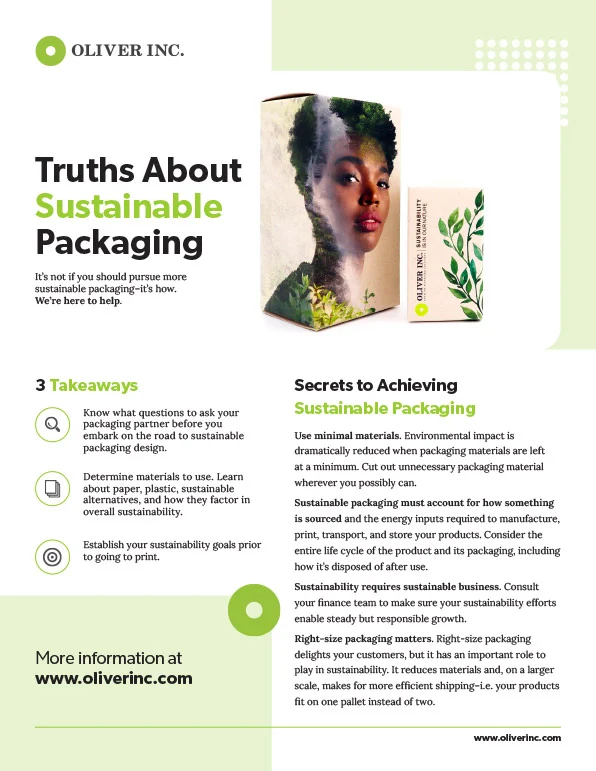5 Printing & Packaging Trends for 2022
Posted by Oliver Inc. on 25th Mar 2022
Packaging seems to have only become more sophisticated and integral to the consumer experience in recent years. It’s not merely a layer for preserving and storing products, but a medium for engaging and delighting consumers.
It also gives brands a chance to tell their story, communicate who they are, and add value to products.
Here are 5 major trends happening in printing and packaging for 2022.
Specialty Coatings & Foil Stampings Growing In Popularity
The application of select decorative treatments has grown in popularity for two main reasons: Brands recognize the need to visually stand out from their competition on shelves or in ecommerce settings. Others have chosen to position their products as ‘premium’ items (especially in emerging markets, like cannabis) and reflect that on their cartons.
For instance, specialty coatings help increase shelf appeal by enhancing graphic quality, texture, and color contrasts. You could also focus on improving the tactile experience for consumers with a combination of matte and glossy finishes with embossing/debossing.
Brands in demand of more complex coloring are also using foil stamping more frequently. Foil stamping increases overall packaging quality perceptions by offering color variety beyond traditional silver and gold stamping options, while also being more sustainable than traditional laminations. Inline cold foil has also made this a viable option for more brands, even those on tight budgets.
Brands Shifting From Plastic to Paperboard
Thanks to the emphasis on investing in sustainable packaging, one trend that likely won’t end soon is reducing plastic use. Brands that can remove secondary packaging altogether have done so. Others have focused on replacing plastic secondary packaging or inserts with board options.
This shift is relatively limited in health and specialty consumer markets, given most secondary packaging is already board-based, while the trend is more prevalent in mass beverages where single-use plastic rings and shrink wrap are being replaced by fiber-based can collars.
When it comes to folding cartons, brands are emphasizing right-size packaging, meaning they use only enough materials to secure and protect products during shipping, storage, and after use. No more wasteful air pockets in packaging.
This trend to smaller package sizes is more common in high-volume food and consumer categories (such as cereal) where large brands are focused on downsizing or ‘lightweighting’ of folding cartons due to packaging optimization efforts and ‘shrinkflation.’
Packaging Customers Look for Consistency, Shorter Lead Times, & Production Flexibility
When evaluating folding carton converters, customers are interested in consistency, high quality, short lead times, production flexibility, and attentive or responsive service providers.
Quality is the primary selection criteria for high-end brands given that packaging needs to align with the brand aesthetic. This means nearly flawless printing, finishing, and folding, with no downstream issues (erecting, filling, etc.) is expected from customers.
Pharmaceutical brands are placing higher importance on lead times given the criticality of shipping drugs as soon as they become FDA-approved. Digital printing, for instance, is one way brands are able to achieve shorter lead times than previously possible.
Smaller brands are valuing flexibility and short-run printing more given a heightened likelihood of small batch orders, just-in-time shipping, and last-minute changes to production needs.
More customers are also looking for a one-stop-shop packaging provider, as well, bringing design, manufacturing, printing, warehousing, and fulfillment under a single roof. This streamlines the printing process by simplifying the number of moving parts compared to coordination with multiple third parties.
Cannabis & CBD Retail Sales Expected to Grow
The cannabis industry is here to stay.
Cannabis and CBD product sales are anticipated to grow 20-30% over the next five years, and they have stringent requirements with which manufacturers must comply.
For instance, medical or recreational marijuana products require child-resistant packaging that meets the performance specifications outlined in federal regulations related to poison prevention packaging standards.
As a result, brands value experience and credibility when looking for packaging partners. Packaging designs are leaning into laminated, tear-resistant, paperboard cartons and trays that can be customized (with inserts) to hold a wide range of products, including edibles, pre-rolls, vape cartridges, vape pens, and concentrates.
Furthermore, cannabis and CBD brands embrace eye-catching decorative treatments, including the use of specialty coatings, foil, and embossing. However, don’t overlook how common more ‘natural’ looking materials or designs are within the industry.
Continued Interest in Chain-of-Custody Certifications & Sustainability
A focus on sustainability has driven an increase in demand for environmentally friendly packaging materials.
Brands are responding to the growing number of eco-conscious consumers by implementing more sustainable materials and tree-free alternatives into packaging. For instance, sustainable brands have implemented paperboard sourced from responsibly managed forests certified by environmental organizations such as Forest Stewardship Council (FSC), Sustainable Forest Initiative (SFI), and Programme for the Endorsement of Forest Certification (PEFC). This enables them to track the materials along the supply chain to send a clear message to consumers that they’ve incorporated sustainable practices.
As a sustainability measure and in response to the recent global supply chain issues, brands are also turning to domestic packaging partners. Shortened supply chains mean a smaller carbon footprint, and the localization of manufacturers ensures brands have a closer eye on printing and packaging operations, avoiding costly errors or missteps that can happen when one can’t visit international facilities on a routine basis.
While trends such as sustainable packaging, increased cannabis and CBD sales, and shorter lead times aren’t likely to reverse anytime soon, it’s difficult to discern when recent global supply chain issues will resolve themselves.
Consult a printing and packaging manufacturer to learn which trends are most relevant to your industry and business needs.






